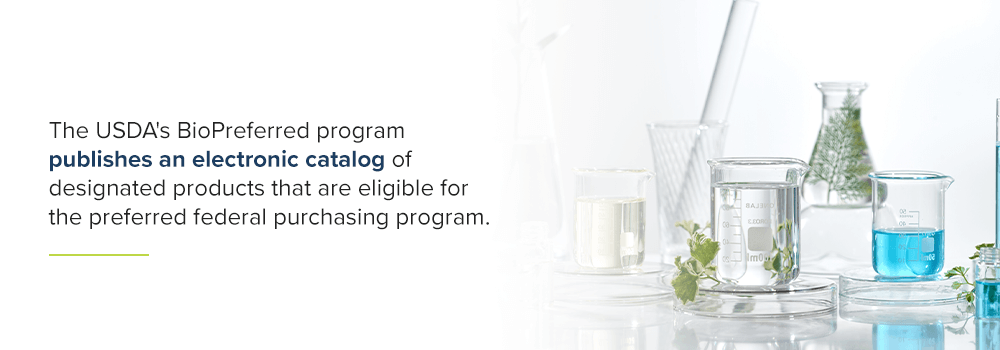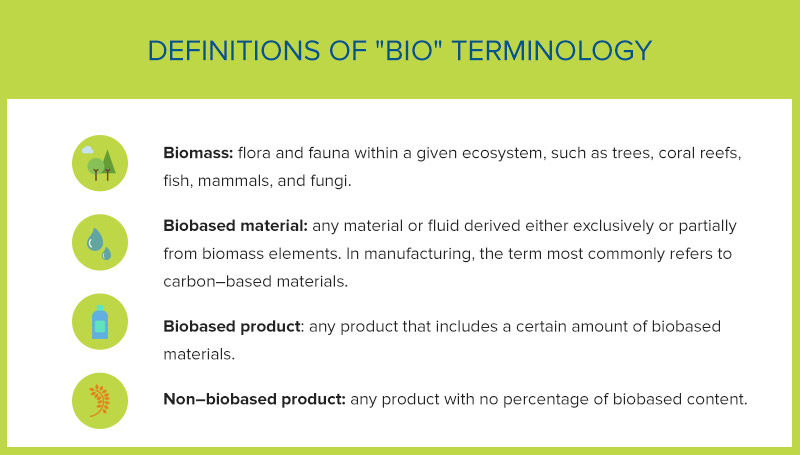What Is a USDA Certified Biobased® Product?
Your complete guide to USDA Certified Biobased products.
USDA Certified Biobased Products
Biobased products are commercial or industrial products made entirely or in significant part from renewable agricultural materials, forestry materials or natural products. These might be materials like crops, other plants or fish. Biobased products must be goods other than food or animal feed.
The Secretary of Agriculture makes the determination of what products can be classified as biobased.
The U.S. Department of Agriculture (USDA) first used this term in 2002, in the Farm Security and Rural Investment Act (FSRIA). The USDA then expanded upon biobased products as a category in the Agriculture Improvement Act of 2018.
Section 9002 of the FSRIA states that federal organizations must procure biobased products within the USDA’s framework. The law requires federal agencies to give preferred purchasing treatment to products legally classified as biobased.
The USDA’s Certified Biobased product program publishes an electronic catalog of designated products that are eligible for the preferred federal purchasing program. Independent laboratory testing has given these products third-party certification for their biobased content. Below are a few examples of the many types of products that can be biobased:
- Baby toys
- Bedding and towels
- Construction materials
- Custodial cleaning products
- Product packaging
- Trash bags
- Cutlery and tableware
- Mulch and compost
- Pest repellants
- Fire logs and fire starters
- Printer inks
- Facial care products
- Aircraft and boat cleaners
- Diesel additives
- Hydraulic fluids
- Sealants and coatings

FAQ About USDA Certified Biobased Products
Some frequently asked questions about USDA Certified Biobased products include:
1. What Is the Vision Behind the USDA BioPreferred Program?
The whole point behind the USDA BioPreferred Program is to incentivize the development of products made from agricultural and biological matter. In doing so, the program hopes to spur job growth in industries committed to utilizing biobased content and to expand the market for USDA Certified Biobased Products among today’s consumers.
2. What Are the Requirements of a USDA Certified Biobased Product?
For a product to gain biobased certification, a list of regulatory steps must be followed in the order given by the USDA. Failure to perform the steps thoroughly and sequentially will render a product uncertified. The USDA recognizes 139 categories of biobased products that agencies have purchasing requirements. All other products must pass a 25% biobased level to meet the requirements. Additionally, as of June 2021, there are more than 16,000 products registered in the BioPreferred Program Catalog.
3. Are There Costs Involved With Product Certification?
Manufacturers are not charged any application or certification fees to be in the USDA BioPreferred Program. However, companies must pay for product-label content testing during the initial application as well as each routine audit. Companies in more than 40 countries participate in the USDA BioPreferred Program. Products can qualify from any nation that has a legal trade agreement with the U.S.
4. How Long Does It Take to Get a Product Certified?
Providing that an applicant answers inquiries in a timely manner, the entire process of approval — application, testing and certification — usually takes 90 days to complete for the USDA BioPreferred Program. However, times can vary due to external factors. Each application is reviewed for accuracy and eligibility by UK multinational consultants Amec Foster Wheeler in partnership with the USDA. Outside laboratory testing for biobased contents is not accepted as a substitute for testing through the program’s protocol.
5. Can Identical Products From the Same Company be Jointly Certified?
If the same company manufactures multiple products with identical formulations, they might qualify as a product family, in which only one of the products would be required to undergo testing. However, any slight variation to the primary formula — such as a different color, mass or scent — is a disqualification for grouping under the family umbrella.
6. Can a Product Share Certification With an Identical Competing Product?
A product might not require testing if its contents are identical to a competing brand’s already certified product. The company seeking test-exemption status would need to apply for that designation, and it would be up to the competing product maker to decide whether to share its certification.
7. Are Companies Subject to Ongoing USDA Scrutiny Once Certification Has Been Granted?
The USDA maintains strict guidelines over the use of BioPreferred terminology on the web pages, advertisements and marketing materials of USDA Certified Products. If a company receives a warning about an apparent violation over one of its products, it must address an immediate response to the USDA on the matter. Otherwise, the company’s product could be stripped of certification.
On products that do acquire the USDA Certified Biobased Product label, the USDA does conduct regular audits to make sure that the products in question maintain the biobased content as listed.
8. Do Changes in Brand/Product/Company Name Affect Certification Status?
If the maker of a USDA Certified Product changes its company, brand or product name, the change must be filed online with the USDA, but this does not affect certification. However, if a company changes the formulation of a product following certification, the change must be described in detail to program staff. The reformulated product might be required to undergo new testing.
9. How Do USDA Certified Biobased Product Manufacturers Find Federal Purchasers?
Once a product is certified, the next step is for the company in question to bring its product to the attention of government agencies for purchase. The USDA assists in this process through its BioPreferred Catalog, which lists all products that meet the requirements for federal repurchasing. Training programs also exist to help companies master the process of generating product sales at the federal level.
10. What Does Biobased Product Testing Ultimately Entail?
To ensure consumer confidence in the biobased contents of products bearing the USDA Certified Biobased Product label, testing is conducted in independent laboratories according to internationally accepted standards. Testing is done via ASTM D6866: an analytic method that uses radiocarbon dating to test particles, fluids or gases of a given product for biobased content.
11. Is USDA Biobased Certification the Equivalent of Green Certification and Ecolabelling?
USDA Biobased Certification is not to be mistaken as an environmental seal of approval on a given product. The percentage of biomass listed on a product indicates the amount of organic contents contained within, but this isn’t to be read as indicating a higher degree of product reliability, safety or eco-friendliness.
The main purpose of biobased manufacturing is to decrease the use of petroleum and the release of noxious gases into the environment. By encouraging formulations with greater biomass, the USDA hopes to steer the industrial sector over time toward productions with no ill effects on the earth’s atmosphere.

12. Requirements for Federal Contractors Regarding USDA Certified Biobased Products
When it comes to product types that fall under the mandatory federal purchasing list, federal agencies are required to give biobased products precedence over inorganic variants. Reports on purchases of USDA Certified Biobased Products by federal contractors are collected by the System for Award Management (SAM). Further information can be accessed at their website. Contractors are advised to report to SAM after each purchase. The federal government’s fiscal year starts on Nov. 1 and wraps on the following Oct. 31.
Biobased Product Categories
Products that fall within the USDA’s 139 biobased categories cover a broad range of user needs. Examples include liquid cleaning supplies, crop fertilizers, lubes and bioplastics. To distinguish the goals of the USDA BioPreferred Program, raw biomass elements such as grains, soybeans, marine plants, forest residues and fuel are not classified as biobased products.
Category Additions and Updates
Further product categories will be added to the federal purchasing list as more information is gathered on said categories. Decisions to this effect are handed down by the government and published in the Code of Federal Regulations, among other places.
Ongoing Goals of the USDA BioPreferred Program
Since the passage of FSRIA, the USDA has furthered the initiative to promote USDA Certified Biobased Products with the USDA BioPreferred Program, which was advanced in the Agricultural Act of 2014 — alternately known as the “Farm Bill.” The USDA BioPreferred Program has two main initiatives:
- Mandatory federal purchasing requirements for USDA Certified Biobased Products
- Voluntary labeling on USDA Certified Biobased Products with sufficient biobased content
Through the USDA BioPreferred Program, federal agencies and contractors can access training information to help in satisfying the requirements of the law. Participant funding is not offered through the BioPreferred Program itself, but interested parties can apply for loans and grants through the Rural Development branch of the USDA.
USDA Certified Biobased Products: What They Mean for Consumers
As the concept of sustainability becomes more popular with the consumer public, the goal of the USDA is to offer an easy way for people to know which products are made in part with sustainable contents. With the USDA Certified Biobased Product label — which displays on products made by companies that apply for and gain USDA certification based on sufficient biobased content — consumers are guaranteed of a product’s use of renewable biomass elements.
Products bearing the label are tested and retested at regular intervals for biobased content at third-party laboratories. The USDA strictly monitors the use of its BioPreferred labeling, all of which ensures the label’s authenticity.
Biobased Terminology: The Basics
To grasp the concept of biobased materials, consumers and sellers must understand the definitions of “bio” terminology:
- Biomass: Flora and fauna within a given ecosystem, such as trees, coral reefs, fish, mammals and fungi.
- Biobased material: Any material or fluid derived either exclusively or partially from biomass elements. In manufacturing, the term most commonly refers to carbon-based materials.
- Biobased product: Any product that includes a certain amount of biobased materials.
- Non-biobased product: Any product with no percentage of biobased content.

How to Determine the Biobased Contents in Products
The biobased-content percentage of a given product is measured by subtracting the biobased carbons from the overall carbon content. The term “Percent Biobased” refers exclusively to the percentage of biobased materials in a product. Therefore, if an over-the-counter oil product has a Percent Biobased value of 55%, that means the other 45% is derived from non-biobased sources. For the most part, the current biobased industry is combining biobased carbons with petroleum-based elements in its products.
Content Calculations: Contents vs. Percentages
A calculation of biobased content is extracted from a product’s carbon percentage but not the overall contents. Therefore, while the overall percentage of biobased content is altered by the ratio of carbon versus petroleum, the actual rating is based exclusively on the percentage of biobased material within the carbon itself.
Odd Calculation 1: High Carbon/Low Biobased Percentage
A product might contain 70% carbon, only 2% of which is derived from biobased materials, in which case the product would be 2% biobased, while the remaining 98% would consist of 68% non-biobased carbon and 30% petroleum substances.
Odd Calculation 2: Low Carbon/High Biobased Percentage
On the other hand, a product could be 100% biobased yet contain only 2% carbon, simply because the carbon itself is derived exclusively from biobased substances. Likewise, a product might consist of merely 0.2% carbon but also be 100% biobased because, once again, the carbon in question is thoroughly derived of biobased matter.
Troubleshooting for Biobased Chemical Suppliers and Product Makers
Due to the often unpredictable nature of petroleum elements, it’s not always easy to tell what the actual biobased content will be in a product. When a manufacturer makes the wrong prediction, there are basically three ways to rectify matters:
- Re-label the product to reflect the actual formulation.
- Locate the maker of the petroleum found in the raw contents.
- Measure each component in the formulation for biobased content.
If the intent is to make a 100% biobased product, and all the components are believed to be carbon derivatives of biomass, the percentage would be altered if petroleum is found in one of the components. The manufacturer would then need to decide whether to adjust the formulation according to the new findings or to find a biobased alternative to the component in question.
Benefits of USDA Certified Biobased Products in the Service Industry
USDA Certified Biobased products have been a big success in the numerous professions and service sectors in which biobased products have been adopted, shared and utilized. Biobased food ware, for example, has proven popular at many universities, where plates and cups made of tapioca, potato starch and grass contents have replaced polystyrene over the past decades.
At the eco-minded University of Wisconsin in Green Bay, the food ware has allowed hungry students to get fueled, energized and wired between classes without leaving mountains of non-biodegradable trash in their wake. According to estimates made at the outset of UW’s biobased food ware initiative in 2008, students were going through 18,000 cups and 50,000 salad containers per month.

USDA Certified Biobased Products: A Boon for Commercial Vehicle Maintenance
The turn toward USDA Certified Biobased Products has also been well-received in fleet maintenance, where oils derived from organic contents are not only advantageous to the environment but for the health of workers who lubricate vehicle parts on a daily basis.
In the mid-2000s, the fleet crew at Tennessee’s Oak Ridge National Laboratory (ORNL) switched to vegetable-derived oil to lubricate corroded auto parts. Turns out, the biobased oil could separate stuck-together parts as quickly and easily as any petroleum-based lubricant. Two years after ORNL made the switch, the facility estimated that it was using only five spray bottles of the biobased oil per year for maintenance on its 500-vehicle fleet.
The Ever-Expanding Market for BioPreferred Chemical Suppliers
Since the 2002 passage of FSRIA, the number of BioPreferred chemical distributors has grown as manufacturers come to understand and harness the benefits of USDA Certified Biobased Product making. As the world has turned increasingly toward renewable energy and waste elimination, sustainable chemical distributors have witnessed a growing demand across the industrial sector.

How Manufacturers Can Be More Sustainable With USDA Certified Biobased Products
USDA Certified Biobased Products displace more than 9 million tons of oil annually, making them a sustainable option for businesses to use. Sustainable business practices help preserve the natural environment and often help a company’s brand image. Reduce your business’s carbon footprint by using biobased alternatives in these categories:
- Coatings, adhesives, sealants and elastomers (CASE): At Acme-Hardesty, we carry biobased CASE products ranging from performance coatings to adhesives and decorative paints.
- Lubricants and grease: Optimize your formulations with biobased lubricants and grease. Our team of experts can help your business bring your metalworking essentials to the next level.
- Industrial cleaning: Industrial cleaning solutions don’t have to compromise sustainability for quality. With ethically sourced ingredients, you can enjoy the best of both worlds at your business.
The Future for Sustainable Chemical Distributors
With biobased contents being added to everything from adhesives, deodorizers, repellents and cleaners to cutlery, tableware, carpets and candles, the contents provided by BioPreferred chemical suppliers are reshaping the way people clean, dine and groom themselves. Over the next 10 years, the market for oleochemicals and other organic contents is set for infinite expansion, as companies and consumers alike see the benefits of switching to biobased products in all areas of everyday living and production.
Sustainability will likely continue seeing growth in the U.S. and worldwide. According to a report by the USDA, the biobased products industry contributed $470 billion to the U.S. economy. Several more factors are influencing the strides toward a biobased economy. Some of these factors include:
- A move toward a more economically and socially sustainable economy.
- The realization that materials such as oil and coal are unrenewable resources and the need to seek alternatives.
- The desire to become less dependent on fossil fuels.
- Rising global concerns about climate change and global warming.
- Looking for rural and regional development worldwide.
Find Biobased Solutions at Acme-Hardesty
At Acme-Hardesty, we supply manufacturers with biobased ingredients and solutions for their needs. We started operations over 70 years ago, and today we’re one of the largest distributors of castor oils and derivatives, palm derivatives and more. We also supply a full range of renewable materials such as fatty acids and fatty alcohols.
Our expert team is dedicated to helping you understand the benefits of ethical sourcing and using biobased products. To receive more information about our products or to receive a quote, fill out our form to contact Acme-Hardesty today.

